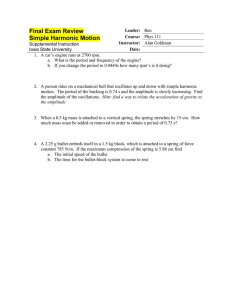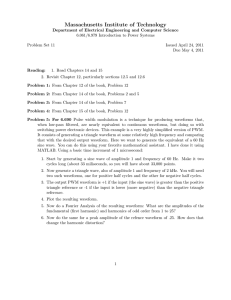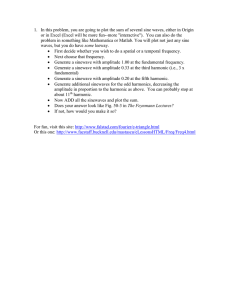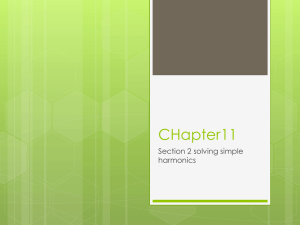Lecture 1-4: Harmonic Analysis/Synthesis
advertisement
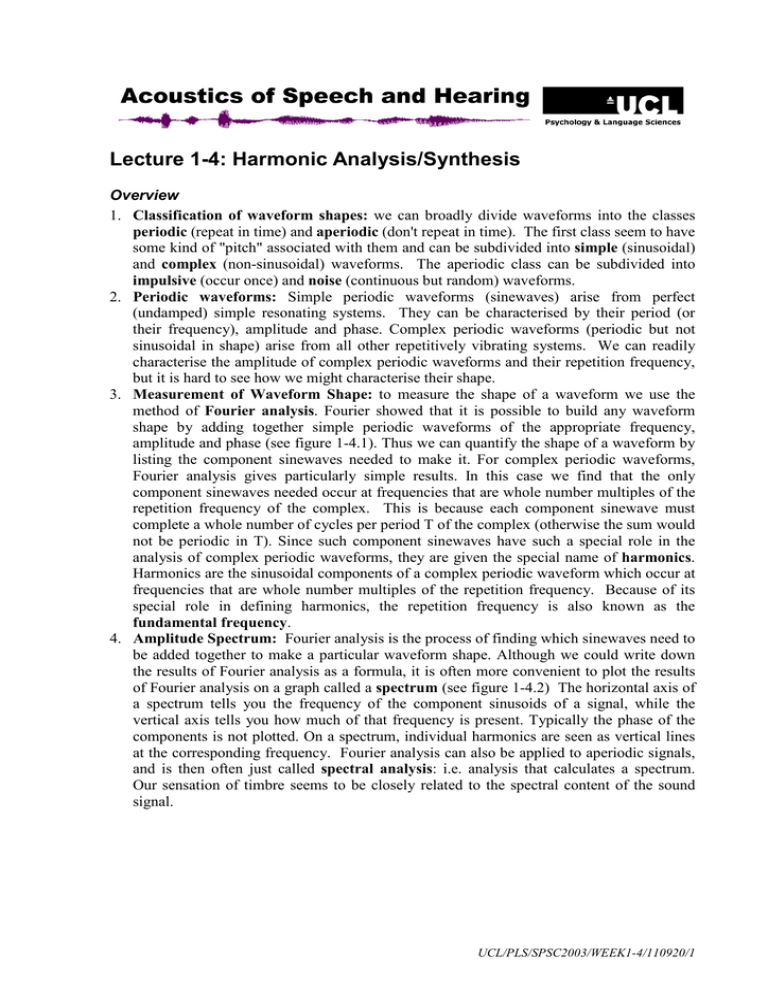
Lecture 1-4: Harmonic Analysis/Synthesis Overview 1. Classification of waveform shapes: we can broadly divide waveforms into the classes periodic (repeat in time) and aperiodic (don't repeat in time). The first class seem to have some kind of "pitch" associated with them and can be subdivided into simple (sinusoidal) and complex (non-sinusoidal) waveforms. The aperiodic class can be subdivided into impulsive (occur once) and noise (continuous but random) waveforms. 2. Periodic waveforms: Simple periodic waveforms (sinewaves) arise from perfect (undamped) simple resonating systems. They can be characterised by their period (or their frequency), amplitude and phase. Complex periodic waveforms (periodic but not sinusoidal in shape) arise from all other repetitively vibrating systems. We can readily characterise the amplitude of complex periodic waveforms and their repetition frequency, but it is hard to see how we might characterise their shape. 3. Measurement of Waveform Shape: to measure the shape of a waveform we use the method of Fourier analysis. Fourier showed that it is possible to build any waveform shape by adding together simple periodic waveforms of the appropriate frequency, amplitude and phase (see figure 1-4.1). Thus we can quantify the shape of a waveform by listing the component sinewaves needed to make it. For complex periodic waveforms, Fourier analysis gives particularly simple results. In this case we find that the only component sinewaves needed occur at frequencies that are whole number multiples of the repetition frequency of the complex. This is because each component sinewave must complete a whole number of cycles per period T of the complex (otherwise the sum would not be periodic in T). Since such component sinewaves have such a special role in the analysis of complex periodic waveforms, they are given the special name of harmonics. Harmonics are the sinusoidal components of a complex periodic waveform which occur at frequencies that are whole number multiples of the repetition frequency. Because of its special role in defining harmonics, the repetition frequency is also known as the fundamental frequency. 4. Amplitude Spectrum: Fourier analysis is the process of finding which sinewaves need to be added together to make a particular waveform shape. Although we could write down the results of Fourier analysis as a formula, it is often more convenient to plot the results of Fourier analysis on a graph called a spectrum (see figure 1-4.2) The horizontal axis of a spectrum tells you the frequency of the component sinusoids of a signal, while the vertical axis tells you how much of that frequency is present. Typically the phase of the components is not plotted. On a spectrum, individual harmonics are seen as vertical lines at the corresponding frequency. Fourier analysis can also be applied to aperiodic signals, and is then often just called spectral analysis: i.e. analysis that calculates a spectrum. Our sensation of timbre seems to be closely related to the spectral content of the sound signal. UCL/PLS/SPSC2003/WEEK1-4/110920/1 Reading Choose at least one from: Ladefoged, Elements of Acoustic-Phonetics (2nd edition), Chapter 4: Wave Analysis. Gentle introduction to Fourier. Rosen & Howell, Signals and Systems for Speech and Hearing (1st edition), Chapter 7: The Frequency Characterization of Signals, pp117-142. Excellent and thorough. Speaks, Introduction to Sound (3rd edition), Chapter 5: Complex Waves. Thorough. Learning Activities You can help yourself understand and remember this week’s teaching by doing the following activities before next week: 1. Write down an explanation for how one might differentiate simple periodic, complex periodic, impulse and noise waveforms by their shape. 2. Write down a description of the inputs and the outputs of Fourier Analysis. 3. Write out definitions in your own words of the terms fundamental frequency, harmonic and spectrum. 4. Draw out to scale the spectrum of a square wave using the formula in Fig 1-4.2. Repeat the graph using a decibel scale for the amplitude axis 5. Describe in general terms what aspect of a signal underlies our perception of its loudness, pitch and timbre. If you are unsure about any of these, make sure you ask questions in the lab or in tutorial. Reflections You can improve your learning by reflecting on your understanding. suggestions for questions related to this week’s teaching. Here are some 1. 2. 3. 4. Think of how you might define timbre. How would you classify the waveforms of these speech sounds: [p], [s], [i:] ? What is a harmonic? If the repetition frequency of a periodic sound is 100Hz, what are the frequencies of its harmonics? 5. If the repetition period of a periodic sound is 10ms, what are the periods of its harmonics? 6. Put arguments against: “Surely some sounds will need an infinite number of harmonics”. 7. What is a spectrum? 8. Why does a square wave have a different timbre to that of a triangular wave of the same amplitude and repetition frequency? 9. How would the spectrum of a sawtooth wave change with increasing amplitude? 10. How would the spectrum of a sawtooth wave change with increasing repetition frequency? UCL/PLS/SPSC2003/WEEK1-4/110920/2 Figure 1-4.1 Harmonic Synthesis Waveform A Frequency = F Period = T Waveform B Frequency = 2F Period = T/2 Waveform C Frequency = 3F Period = T/3 Waveform A+B Period = T Waveform A+C Period = T Waveform B+C Period = T Waveform A+B+C Period = T Waveform A+B+C with A shifted by 90º Period = T Note in the last two examples that changing the phase of the components can radically change the shape of the composite waveform. However phase is not shown in the conventional spectrum graph. UCL/PLS/SPSC2003/WEEK1-4/110920/3 Figure 1-4.2 Spectra of some commonly occurring waveforms Waveform Amplitude Spectrum dB Spectrum The dB Spectrum is just the amplitude spectrum with the amplitude scale converted to decibels with the formula dB = 20.log(amplitude/1). The spectra of sounds comprised of harmonics with widely varying amplitudes are easier to interpret on a dB amplitude scale. UCL/PLS/SPSC2003/WEEK1-4/110920/4 Quiz - Harmonic Spectra For the following combinations of sinusoids, determine: The amplitude ratio of each component to 20µPa. The amplitude of each component in dBSPL. The fundamental frequency and harmonic numbers. a) b) c) 100Hz at 20µPa Ratio= Ratio(dBSPL)=_____ 200Hz at 40µPa Ratio= Ratio(dBSPL)=_____ 300Hz at 200µPa Ratio= Ratio(dBSPL)=_____ Fundamental(Hz)= Harmonic numbers=_______________ 500Hz at 20µPa Ratio= Ratio(dBSPL)=_____ 1500Hz at 10µPa Ratio= Ratio(dBSPL)=_____ 2500Hz at 5µPa Ratio= Ratio(dBSPL)=_____ Fundamental(Hz)= Harmonic numbers=_______________ 400Hz at 0.002Pa Ratio= Ratio(dBSPL)=_____ 500Hz at 0.04Pa Ratio= Ratio(dBSPL)=_____ 700Hz at 0.2Pa Ratio= Ratio(dBSPL)=_____ Fundamental(Hz)= Harmonic numbers=_______________ UCL/PLS/SPSC2003/WEEK1-4/110920/5 Lab 1-4: Harmonic Synthesis Introduction Fourier's discovery that any periodic waveform can be constructed by adding together sinewave components was a major milestone in mathematics. The sinewave components of a periodic waveform each have a period which is an integer fraction of the fundamental period of the waveform, or in other words, each component occurs at a frequency which is an integer multiple of the fundamental frequency. These components are called harmonics. This gives us a method for the quantification of the composition of a periodic signal: find the constituent components and measure their amplitude. This harmonic analysis is represented on a graph called a spectrum. In this laboratory, we will demonstrate this idea by building periodic waveforms from their constituent sinewaves: harmonic synthesis. Scientific Objectives • To investigate how changes to harmonic spectra affect perceived timbre. • To investigate the character of harmonic spectra that have a vowel-like timbre. Learning Objectives • To understand the terms: fundamental frequency, harmonic, amplitude and phase. • To appreciate how harmonic analysis leads to the quantification of frequency content. • To be able to measure amplitudes in decibels. • To be able to interpret a spectrum. Apparatus You will be using a computer program for harmonic synthesis (Esynth: http://www.phon.ucl.ac.uk/resource/sfs/esynth.htm) which allows you to select harmonics and specify their amplitude, merely by 'pointing' with the mouse at an amplitude spectrum on the screen. You will see the resulting waveform and you will be able to replay the waveform to see how it sounds. Observations For these observations, ensure the program is in its 'harmonic' mode (Options menu: Harmonise ticked, Fx=200Hz). All sinewave frequencies will be forced to the nearest multiple of 200Hz. 1. Single Sinewaves. Use the mouse to move a single harmonic to different frequencies, amplitudes and phases. Note the effect of changing these parameters on the waveform and on the sound. Add in a second sinewave and look at how the two sinewaves add to make a different waveform shape (e.g. add 1000Hz + 1200Hz with View|Output Components) 2. Simple waveshapes. Use the program to recreate the waveforms in figure 1-4.1 composed of the first, second and third harmonic in different combinations (1+2, 1+3, 2+3, 1+2+3). Use F=200Hz in your simulations. In each case measure the fundamental period. What effect does changing the phase of the first harmonic on (i) the waveform shape, (ii) the quality of the sound? What can you infer from this? 3. Designer waveshapes. Use the program to create a square wave and a triangular wave as seen in figure 1-4.2. For a square wave, you will only need to use the odd numbered harmonics, and the amplitude of the nth harmonic should be set to 1/n. Since this is difficult to set when n is large, change the amplitude scale to logarithmic (Options: decibel scale) and select the amplitudes in decibels instead. The formula for decibels is just UCL/PLS/SPSC2003/WEEK1-4/110920/6 amplitude Amplitude(dB) = 20 log 10 reference Esynth uses a reference of 1 for this calculation. You may like to copy and complete the table below before you start: harmonic 1 3 5 7 etc amplitude 1 1/3 1/5 1/7 etc amplitude (dB) 0 -9.5 -14.0 phase 0 0 0 etc etc For a triangular wave, again only use the odd numbered harmonics, but with amplitudes 1/n2 for the nth harmonic alternately changing in sign. Again this is easier to set on the decibel scale, so copy and complete the table below: harmonic 1 3 5 7 etc amplitude 1 -1/9 1/25 -1/49 etc amplitude (dB) 0 phase 0 etc etc 4. Vowel-like waveforms. Try to build noises which sound like the vowels /h9/, /@9/ and /29/ by putting humped clusters of harmonics around these frequencies: vowel hump1 (Hz) hump2 (Hz) hump3 (Hz) h9 200-400 2200-2600 3200-3600 @9 600-800 1000-1200 3600-3800 29 400-600 1400-1600 2400-2600 Print out your best results. You can also analyse a vowel of your own. Record a steady vowel using the Signal/Record option and zoom in so that about ten cycles of waveform fill the screen. Select about five cycles and use Signal/Fourier Analysis (Find Fx) to get Esynth to estimate the harmonic spectrum. Print out the results and compare with your manual attempts. 5. "The problem of the missing fundamental". You can use the Esynth program to demonstrate an interesting phenomenon in pitch perception. First create a pulse train using about 5 equally sized harmonics, like this: harmonic 1 2 3 4 etc amplitude 0.5 0.5 0.5 0.5 etc amplitude (dB) -6 -6 -6 -6 etc phase 90 90 90 90 etc UCL/PLS/SPSC2003/WEEK1-4/110920/7 Listen to this tone and get a sense of its pitch. Now delete the first harmonic – the tone will change in timbre but not in pitch. Try this out for yourself. Can you think why this effect was confusing to the early pioneers in pitch perception? Concluding Remarks What have we learned in this lab about how the ear processes sounds? (Hint: think about waveform shape and timbre, first harmonic and pitch). UCL/PLS/SPSC2003/WEEK1-4/110920/8
